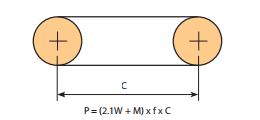Introduction
A mindful evaluation in the disorders surrounding a conveyor is important for precise conveyor chain assortment. This part discusses the fundamental concerns necessary for successful conveyor chain variety. Roller Chains are often employed for light to reasonable duty material dealing with applications. Environmental circumstances could call for using specific resources, platings coatings, lubricants or even the skill to operate with out added external lubrication.
Basic Info Needed For Chain Choice
? Type of chain conveyor (unit or bulk) which includes the system of conveyance (attachments, buckets, through rods etc).
? Conveyor layout which includes sprocket areas, inclines (if any) as well as the number of chain strands (N) to become applied.
? Amount of material (M in lbs/ft or kN/m) and sort of material to be conveyed.
? Estimated bodyweight of conveyor parts (W in lbs/ft or kN/m) together with chain, slats or attachments (if any).
? Linear chain velocity (S in ft/min or m/min).
? Environment through which the chain will operate which include temperature, corrosion circumstance, lubrication issue and so forth.
Step one: Estimate Chain Stress
Utilize the formula under to estimate the conveyor Pull (Pest) then the chain stress (Test). Pest = (M + W) x f x SF and
Check = Pest / N
f = Coefficient of Friction
SF = Pace Factor
Phase two: Make a Tentative Chain Assortment
Applying the Test value, produce a tentative assortment by deciding upon a chain
whose rated operating load better than the calculated Test worth.These values are proper for conveyor support and therefore are diff erent from individuals shown in tables on the front of your catalog that are related to slow speed drive chain utilization.
On top of that to suffi cient load carrying capacity frequently these chains should be of a selected pitch to accommodate a desired attachment spacing. As an example if slats are to be bolted to an attachment each and every one.five inches, the pitch from the chain chosen will have to divide into 1.5?¡À. Hence a single could use a 40 chain (1/2?¡À pitch) with the attachments each 3rd, a 60 chain (3/4?¡À pitch) with the attachments each 2nd, a 120 chain (1-1/2?¡À pitch) using the attachments every single pitch or maybe a C2060H chain (1-1/2?¡À pitch) with the attachments each and every pitch.
Phase three: Finalize Selection – Calculate Actual Conveyor Pull
After producing a tentative assortment we have to verify it by calculating
the actual chain tension (T). To perform this we must fi rst calculate the actual conveyor pull (P). In the layouts shown around the suitable side of this webpage select the proper formula and determine the total conveyor pull. Note that some conveyors could possibly be a combination of horizontal, inclined and vertical . . . in that situation calculate the conveyor Pull at each and every section and add them together.
Stage 4: Determine Optimum Chain Tension
The utmost Chain Stress (T) equals the Conveyor Pull (P) as calculated in Phase 3 divided from the variety of strands carrying the load (N), occasions the Velocity Factor (SF) shown in Table two, the Multi-Strand Issue (MSF) shown in Table 3 plus the Temperature Component (TF) proven in Table 4.
T = (P / N) x MSF x SF x TF
Step 5: Verify the ?¡ãRated Operating Load?¡À of the Selected Chain
The ?¡ãRated Operating Load?¡À on the selected chain should be higher than the Optimum Chain Tension (T) calculated in Stage 4 over. These values are acceptable for conveyor services and are diff erent from individuals shown in tables at the front in the catalog that are associated with slow pace drive chain usage.
Step six: Check out the ?¡ãAllowable Roller Load?¡À of the Chosen Chain
For chains that roll over the chain rollers or on prime roller attachments it is essential to examine the Allowable  Roller Load?¡À.
Roller Load?¡À.
Note: the Roller load is determined by:
Roller Load = Wr / Nr
Wr = The total weight carried from the rollers
Nr = The amount of rollers supporting the fat.
Conveyor Chain Assortment
Tags
